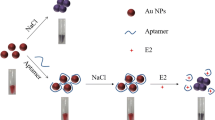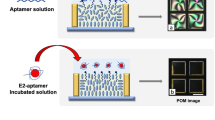Abstract
The estrogenic compound 17β-estradiol (E2) is widely studied for its potential endocrine disruption effects. Due to the low level of E2 present in the environment, it is highly desirable to develop a sensitive and efficient separation and enrichment method for E2 analysis. In this paper, we proposed a novel E2 preconcentration method using anti-E2 aptamer-anchored isothiocyanate-modified beads (NCS beads). The glass beads are chemically modified with primary amino group, and then treated with phenylene diisothiocyanate (PDITC) to generate an isothiocyanate group, which is reactive towards the amine group. The amino-modified anti-E2 aptamer can be easily covalently immobilized onto the as-prepared NCS beads. The experimental results demonstrated that the aptamer affinity microbeads could selectively retain and separate E2 compound. The effects of the operation parameters on retention of E2, including washing condition, eluting condition, the number of beads, and the incubation time were investigated. Moreover, high-performance liquid chromatography with preconcentration of E2 on the aptamer affinity microbeads was applied to detect the E2 in the spiked water samples and obtained a good recovery.






Similar content being viewed by others
References
Ternes TA, Stumpf M, Mueller J, Haberer K, Wilken RD, Servos M (1999) Behavior and occurrence of estrogens in municipal sewage treatment plants-I. Investigations in Germany, Canada and Brazil. Sci Total Environ 225(1–2):81–90
Cargouet M, Perdiz D, Mouatassim-Souali A, Tamisier-Karolak S, Levi Y (2004) Assessment of river contamination by estrogenic compounds in Paris area (France). Sci Total Environ 324(1–3):55–66
Servos MR, Bennie DT, Burnison BK, Jurkovic A, McInnis R, Neheli T, Schnell A, Seto P, Smyth SA, Ternes TA (2005) Distribution of estrogens, 17beta-estradiol and estrone, in Canadian municipal wastewater treatment plants. Sci Total Environ 336(1–3):155–170
Fernández-Alvarez P, Noir ML, Guieysse B (2009) Removal and destruction of endocrine disrupting contaminants by adsorption with molecularly imprinted polymers followed by simultaneous extraction and phototreatment. J Hazard Mater 163(2–3):1107–1112
Bravo JC, Garcinuno RM, Fernandez P, Durand JS (2007) A new molecularly imprinted polymer for the on-column solid-phase extraction of diethylstilbestrol from aqueous samples. Anal Bioanal Chem 388(5–6):1039–1045
Noppe H, Le Bizec B, Verheyden K, De Brabander HF (2008) Novel analytical methods for the determination of steroid hormones in edible matrices. Anal Chim Acta 611(1):1–16
Wei H-B, Lin J-M, Wu D-N, Zhao L-X, Li Z-J, Ying X-T (2007) Detection of 17[beta]-Estradiol in River Water and Human Urine by Highly Sensitive Chemiluminescence Enzyme Immunoassay. Chin J Anal Chem 35(3):319–324
Mishra A, Joy KP (2006) HPLC-electrochemical detection of ovarian estradiol-17beta and catecholestrogens in the catfish Heteropneustes fossilis: seasonal and periovulatory changes. Gen Comp Endocrinol 145(1):84–91
Wang L, Cai YQ, He B, Yuan CG, Shen DZ, Shao J, Jiang GB (2006) Determination of estrogens in water by HPLC-UV using cloud point extraction. Talanta 70(1):47–51
Wozei E, Hermanowicz SW, Holman HY (2006) Developing a biosensor for estrogens in water samples: study of the real-time response of live cells of the estrogen-sensitive yeast strain RMY/ER-ERE using fluorescence microscopy. Biosens Bioelectron 21(8):1654–1658
Hahn T, Tag K, Riedel K, Uhlig S, Baronian K, Gellissen G, Kunze G (2006) A novel estrogen sensor based on recombinant Arxula adeninivorans cells. Biosens Bioelectron 21(11):2078–2085
Ellington AD, Szostak JW (1990) In vitro selection of RNA molecules that bind specific ligands. Nature 346(6287):818–822
Tuerk C, Gold L (1990) Systematic evolution of ligands by exponential enrichment: RNA ligands to bacteriophage T4 DNA polymerase. Science 249(4968):505–510
Ellington AD, Szostak JW (1992) Selection in vitro of single-stranded DNA molecules that fold into specific ligand-binding structures. Nature 355(6363):850–852
Liu J, Cao Z, Lu Y (2009) Functional nucleic acid sensors. Chem Rev 109(5):1948–1998
Haes AJ, Giordano BC, Collins GE (2006) Aptamer-based detection and quantitative analysis of ricin using affinity probe capillary electrophoresis. Anal Chem 78(11):3758–3764
Clark SL, Remcho VT (2002) Aptamers as analytical reagents. Electrophoresis 23(9):1335–1340
Yamamoto-Fujita R, Kumar PK (2005) Aptamer-derived nucleic acid oligos: applications to develop nucleic acid chips to analyze proteins and small ligands. Anal Chem 77(17):5460–5466
Stadtherr K, Wolf H, Lindner P (2005) An aptamer-based protein biochip. Anal Chem 77(11):3437–3443
Jenison RD, Gill SC, Pardi A, Polisky B (1994) High-resolution molecular discrimination by RNA. Science 263(5152):1425–1429
Kato T, Takemura T, Yano K, Ikebukuro K, Karube I (2000) In vitro selection of DNA aptamers which bind to cholic acid. Biochim Biophys Acta 1493(1–2):12–18
Kim YS, Jung HS, Matsuura T, Lee HY, Kawai T, Gu MB (2007) Electrochemical detection of 17beta-estradiol using DNA aptamer immobilized gold electrode chip. Biosens Bioelectron 22(11):2525–2531
Sheng H, Ye BC (2009) Different strategies of covalent attachment of oligonucleotide probe onto glass beads and the hybridization properties. Appl Biochem Biotechnol 152(1):54–65
Acknowledgments
This work was financially supported by the Shanghai project (09JC1404100), the National Special Fund for SKLBE (2060204), NCET-07-0287, and the Fundamental Research Funds for the Central Universities.
Author information
Authors and Affiliations
Corresponding author
Rights and permissions
About this article
Cite this article
Dong Huy, G., Jin, N., Yin, BC. et al. A novel separation and enrichment method of 17β-estradiol using aptamer-anchored microbeads. Bioprocess Biosyst Eng 34, 189–195 (2011). https://doi.org/10.1007/s00449-010-0460-4
Received:
Accepted:
Published:
Issue Date:
DOI: https://doi.org/10.1007/s00449-010-0460-4




